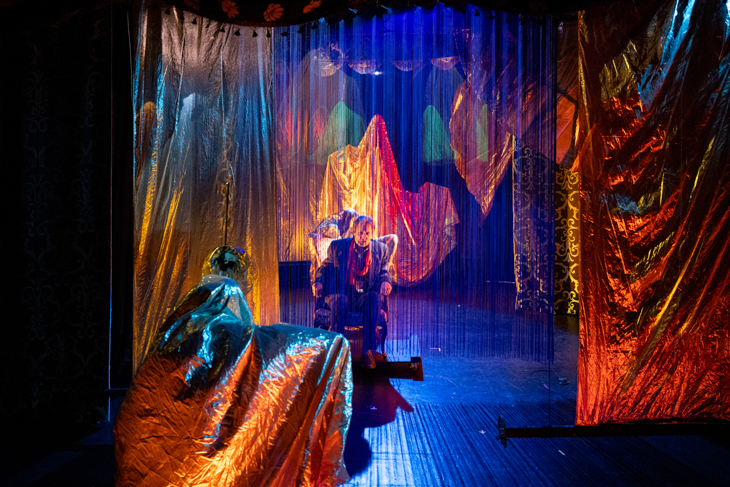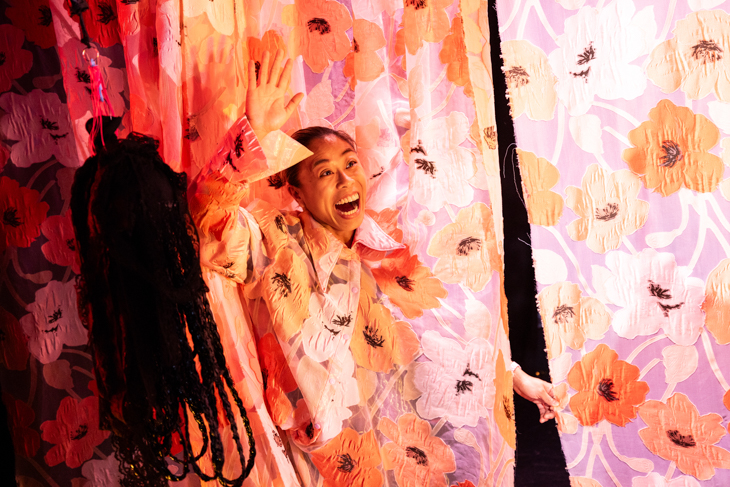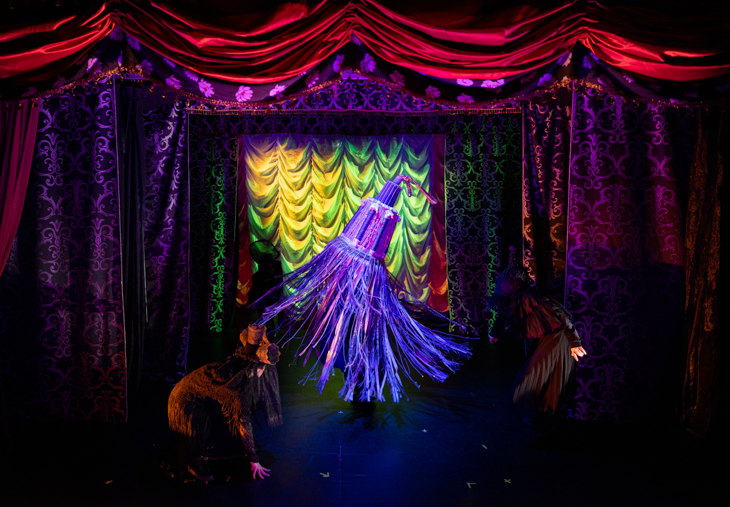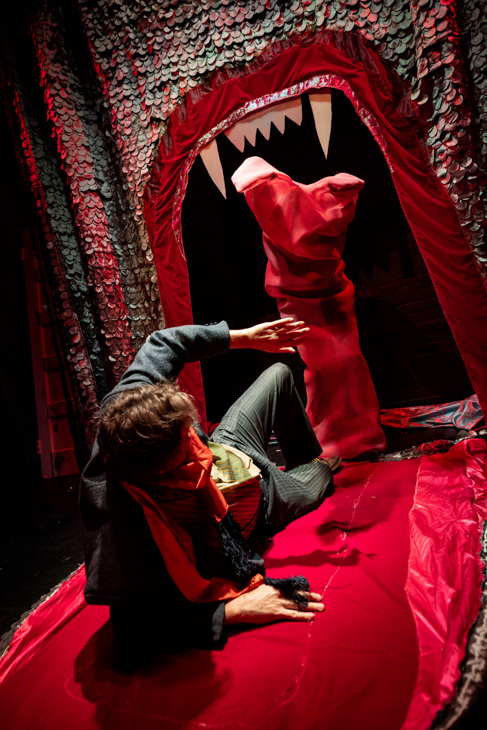Psychic Self Defense. Created, Written, Directed, and Designed by Normandy Sherwood. Dream Music Puppetry Program. HERE Arts Center, New York, NY. September 12-30, 2023.
On a crisp September night in New York, I stand outside the HERE Arts Center by the backstage entrance waiting to see Psychic Self Defense, the fall production of HERE’s Dream Music Puppetry program. It feels like the show has already begun when the usher escorts the audience in small groups from the lobby, where everyone has been congregating, back to the street toward the backstage entrance.
A creature in a tall headdress with a lacy beaded veil greets our group of four at the door and silently motions us to follow. The labyrinth of fabric and fringe curtains surprise me with colors, textures, and patterns at every turn. Our guide stops to ring one of the many handbells assembled on a small table. At the next turn, the guide waves their hand by the antenna of a small transistor radio, and it responds with a wave of electronic sound, like a theremin.
Finally, the last curtain is drawn open and the small auditorium of the proscenium theatre is revealed to us. Each traveler receives a small piece of fabric or trim as a whimsical keepsake and perhaps a small token of reality to hold onto during the hallucinatory experience about to unfold. As I fiddle with the pink metallic ribbon that was given to me, my eyes feast on the luxurious fabrics enveloping the auditorium. HERE’s black box theatre has been transformed into a soft container; the colorful walls surround the seating area. Elaborately decorated round covers have been placed on every seat. The temperature inside this large “fabric box” feels warmer than the outside, which makes it cozy and only slightly claustrophobic. I feel comforted by the soft embrace of this womb-like environment, yet the electronic noise/music (composition and sound by Craig Flanagin) is unsettling and even anxiety-provoking. Finally, the lights dim and the first curtain glides open, only to reveal a second one.
“At least 45 minutes of curtains opening” is how Normandy Sherwood, the creator, writer, designer, and director of the show describes the initial creative impulse behind Psychic Self Defense in the post-show Q&A. “And closing,” she adds, “because there is only that much depth of stage that you have.” In a nutshell, Psychic Self Defense is exactly that: an elaborate dance of opening and closing curtains. But what the curtains reveal is not easy to sum up, even when it is “just” more curtains.
Although Psychic Self Defense features live performers, the main focus of the show is on the choreography of the various fabrics and materials brought to life by rigs or performers (almost like wearable sculptures made of fabric). “I have determined to master the art of psychic self-defense,” declares a man in an armchair (Ean Sheehy) wearing a dark suit and red necktie. This is the only line of dialogue in the show, and possibly the only connection to the literary source by the same name that Sherwood’s creation is based on. “Psychic Self Defense” is a 1930 practical guide on how to protect oneself from the acts of the paranormal, written by British occultist Dion Fortune.

Soon after the man announces his intention, and telekinetically pushes the sparse elements of his living room offstage (the armchair and snake plant are pulled away on gently rattling dollies, causing a chuckle in the audience), a woman (Nikki Calonge) appears. After studying various insects with a large magnifying glass, she declares that same intention to master the art of psychic self-defense, then steps into a portal formed by a light pattern on a large piece of fabric that looks like a carpet (lighting design by Christina Tang). The carpet begins to lift higher and higher behind her until it too disappears into the curtain folds (scenic and rigging design by Daniel Allen Nelson).
What follows is the surreal journey of the two human characters into the world “on the other side.” After more curtains open and fall, making way for a magical dance of veiled figures (combining live actors, shadow theatre, and video projections), the two human protagonists meet. Three handbells drop down from the ceiling and dangle invitingly on strings. This is a familiar fairytale set-up: a triad of magical objects, the choice of each resulting in which branch of a forking path the character will take and, ultimately, their destiny. In the moment, it reminded me of Lewis Carol’s Alice’s Adventures in Wonderland with its enchanted cakes and potions but with darker, more mysterious undertones.
Calonge’s character rings one of the bells and a pile of golden tinsel lands on her head, paralyzing her for a moment. Her mighty effort to free herself from this pile of golden noodles is accompanied by a screeching sound effect that underscores the unfamiliar quality of this material. Tang’s frozen facial expression emerges from under the tinsel in an uncanny expression that seems to mix horror with glee––it’s hard to tell if she is laughing or in pain. The mass of tinsel then becomes a character, manipulated by Tang with its own unique physique and choreography. In this moment the line between acting and object animation is teased deliciously.
From then on, the woman slowly gets sucked into the magical world and eventually gets woven into its fabric, quite literally. Every time we see her she seems to be merging more and more with the material, and starting to enjoy it. Her appearance in a costume that is sewn into a curtain is funny, yet uncanny at the same time. It is impossible to distinguish where the woman’s shirt ends and the curtain begins as they appear to be merged into one. Her deep integration into the fabric on a nearly elemental level culminates in a joyous dance with giant tassels towards the end of the show, when she herself is dressed like a tassel.

As the show progresses, we encounter more fantastical inhabitants, and with each new reveal the sense of wonder this generates grows. The theatrical curtains become surreal creatures living their own lives, dancing their own dance. Their appearance bends theatrical conventions, blurring the lines between pieces of scenery, props and characters. Some of the curtains appear multiple times, pulled from one wing to the opposite, but even that simple movement is used as an opportunity for play as the direction and tempo of the curtains’ “dances” vary. I find myself giving names to my favorite curtains, like Shimmering Waterfall or Flowerfield, and I am happy to see them reappear again and again.
Sherwood, the creator of the show, explores many opportunities presented by the challenge of animating fabric. Varying the proximity between the fabric and the human skin, she plays with the idea of merging the two. From a brief interlude of gloved hands dancing in the slit between two curtains, to a curtain-dress worn by Calonge, to the veiled inhabitants of the mystical world and, finally, to the entrance of a monumental sculpture-like tassel Sherwood and her collaborators explore the depths of the relationships between human bodies and bodies of fabric in playful, delightful, and even spooky ways.

With some of the costumes, the human forms inside them are still legible (for example, the creatures in black dresses and beaded veils). But some of the other costumes could be considered wearable fabric sculptures. My favorite was a fairground puppet booth which was “dressed” exactly like the HERE stage, on which a miniature version of the opening of Psychic Self Defense played out. It then revealed within it an even smaller booth with even smaller “performers.” The meta-theatrical element was doubled by the appearance of yet another booth, next to the first, similar in size and shape but in a different color scheme. The dance of the two booths pushed the visual joke into the realm of the absurd.
Perhaps the most memorable stars of the show were the oversized tassels. One of them was so big it had to be moved by the performer standing on a dolly (unlike the smaller tassels which were worn like costumes). I couldn’t stop thinking of these figures’ resemblance to Yoruba Egungun ritual costumes, which are created with layered fabric and represent the spirits of departed ancestors. This parallel was perhaps not intended by the creators of the show but seems fitting considering some other visual metaphors of death: black veils and multiple instances of fabric devouring objects and people.
By the end, Psychic Self Defense had become an existentialist story of two alternative ways to navigate a journey to some inevitable destination (e.g. death). The female character chose to entrust her body to the transformation, ultimately becoming something else. The man chose the journey of a “warrior,” which ended in his tragicomical, fatal struggle with a giant tongue (a performer in a bodysuit) at the gate of a cartoonish Hellmouth with scales at the edges and snake-like fangs. And, finally, the audience members themselves are put face-to-face with the reality of theatrical pretense––perhaps a metaphor for life itself––when the curtains around them drop, revealing one of the uncanny characters operating the soundboard.

The beauty of Psychic Self Defense is in the show’s complete trust in materials to reveal their own narratives. Punctuated by electronic music, light, and projections, and animated by human bodies and rigs, the pieces of fabric are left to dance their own dance, inviting the audience’s imagination to interpret or just be hypnotized by them. Some might enjoy this show as an abstract “live action screen saver,” as it is described in the marketing materials. Some might read narratives of journeys into it. The playful flexibility of this unique spectacle gives rise to both intellectual ponderings and a nearly haptic pleasure in witnessing the meaningful performance of fabric. .
Asya Gorovits
The Graduate Center, CUNY

